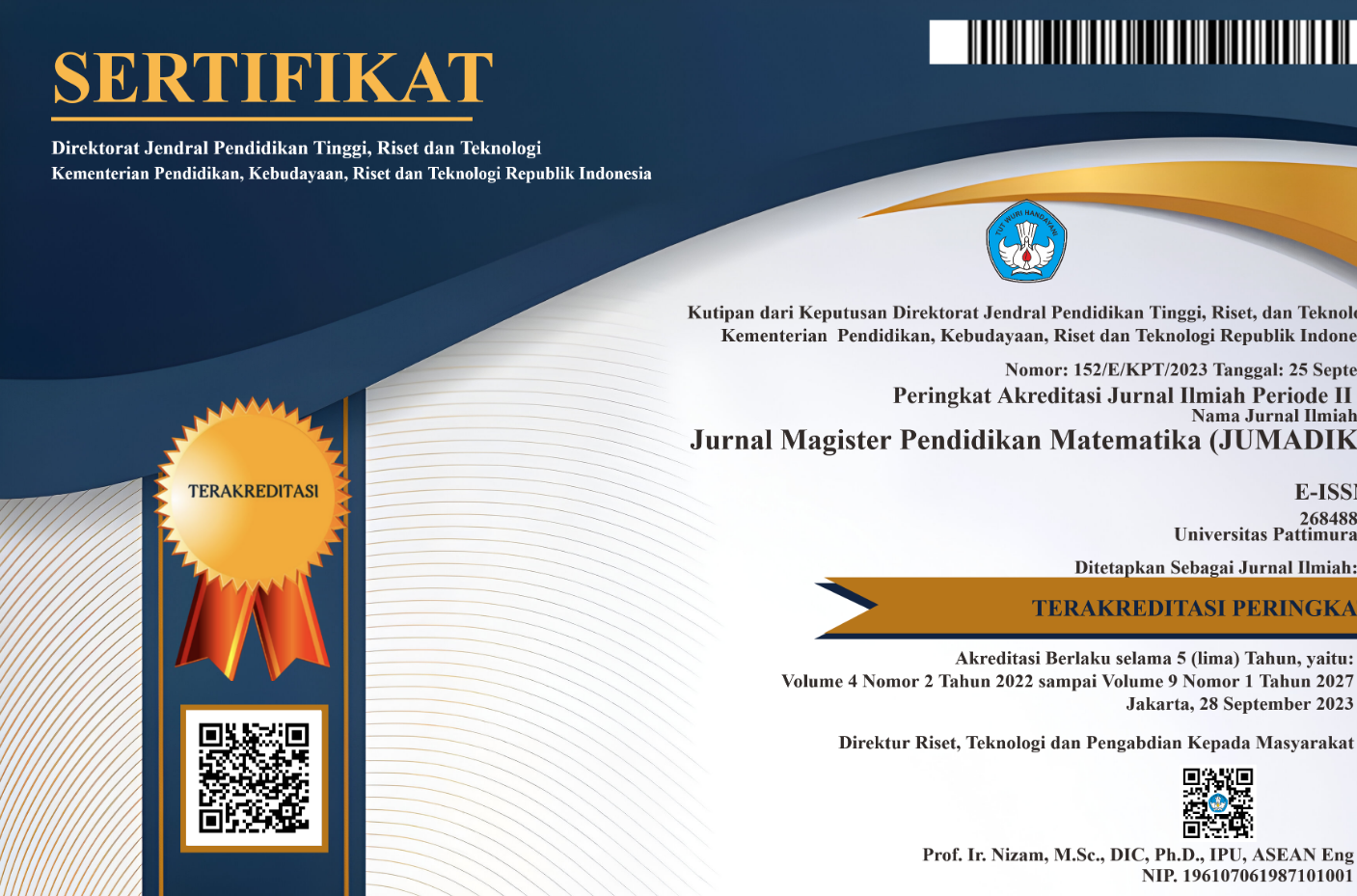PERSEPSI MAHASISWA DALAM MEMVALIDASI BUKTI MATEMATIS
Abstract
This study aims to describe the perceptions of prospective students in the first year in validating mathematical proof. This student's perception is discussed based on the answers given to the proof of a theorem. This research is a qualitative research. The subjects in this study were three students from the second semester mathematics education study program at a university in East Java. Research subjects were chosen deliberately with the following considerations: prospective teacher students who use examples in making mathematical proof and good communication skills make research can facilitate students' perceptions in writing mathematical proof. The results showed that students had perceptions about who gave several examples so that the proof was called valid, one example of denying it could prove it was invalid and using formal proof that proved it could be proven valid
Downloads
References
Almeida, D. (2000). A survey of mathematics undergraduates’ interaction with proof : some implications for mathematics education. 31(6), 869–890.
Anapa, P. Õ. (2010). Investigation of undergraduate students ’ perceptions of mathematical proof. 2, 2700–2706. https://doi.org/10.1016/j.sbspro.2010.03.399
Aylar, E. (2014). A Study on the Forms of Perception of 7th Grade Students towards the Concept of Proof. Journal of Education and Future, 5, 39–56.
Ball, D. L., Hoyles, C., Jahnke, H. N., & Movshovitz-Hadar, N. (2003). The teaching of proof. III. http://arxiv.org/abs/math/0305021
Basturk, S. (2010). First-year secondary school mathematics students’ conceptions of. 36(3), 283–298. https://doi.org/10.1080/03055690903424964
Hazzan, O., & Zazkis, R. (2003). Mimicry of proofs with computers: The case of Linear Algebra. International Journal of Mathematical Education in Science and Technology, 34(3), 385–402. https://doi.org/10.1080/0020739031000108628
Herbst, P. G. (2002). Engaging students in proving: A double bind on the teacher. Journal for Research in Mathematics Education, 33(3), 176–203. https://doi.org/10.2307/749724
Lesseig, K., Hine, G., & Na, G. S. (2019). Perceptions on proof and the teaching of proof : A comparison across preservice secondary teachers in Australia, USA and Korea. https://doi.org/10.1007/s13394-019-00260-7
Moore, R. C. (1994). Making the transition to formal proof*. 249–266.
Moralı, S., Ugurel, I., Türnüklü, E., & Yeşildere, S. (2006). The views of the mathematics teachers on proving. Kastamonu Education Journal, 14(1), 147–160.
Studies, I. E. (2016). Preservice Mathematics Teachers’ Metaphorical Perceptions towards Proof and Proving. 9(7), 88–97. https://doi.org/10.5539/ies.v9n7p88
Stylianides, A. J. (2007). Proof and proving in school mathematics. Journal for Research in Mathematics Education, 38(3), 289–321.
Stylianides, A. J., Stylianides, G. J., & Philippou, G. N. (2004). Undergraduate students’ understanding of the contraposition equivalence rule in symbolic and verbal contexts. 133–162.
Tuba, F., Övez, D., & Özdemir, E. (2014). The Investigation of Prospective Mathematics Teachers’ Proof Writing Skills and Proof Self- Efficacy. Procedia - Social and Behavioral Sciences, 116(2010), 4075–4079. https://doi.org/10.1016/j.sbspro.2014.01.893
Velleman, D. (2006). How to Prove It: A structed Approach (Vol. 60, Issue 4, p. 1329). https://doi.org/10.2307/2275901
Weber, K. (2001). Student difficulty in constructing proofs: The need for strategic knowledge. Educational Studies in Mathematics, 48(1), 101–119. https://doi.org/10.1023/A:1015535614355.
Copyright (c) 2020 Christi Matitaputty

This work is licensed under a Creative Commons Attribution-NonCommercial-ShareAlike 4.0 International License.
License and Copyright Agreement
In submitting the manuscript to the journal, the authors certify that:
- They are authorized by their co-authors to enter into these arrangements.
- The work described has not been formally published before, except in the form of an abstract or as part of a published lecture, review, thesis, or overlay journal. Please also carefully read Jurnal Magister Pendidikan Matematika (JUMADIKA) Posting Your Article Policy.
- That it is not under consideration for publication elsewhere,
- That its publication has been approved by all the author(s) and by the responsible authorities – tacitly or explicitly – of the institutes where the work has been carried out.
- They secure the right to reproduce any material that has already been published or copyrighted elsewhere.
- They agree to the following license and copyright agreement.
Copyright
Authors who publish with Jurnal Magister Pendidikan Matematika (JUMADIKA) agree to the following terms:
- Authors retain copyright and grant the journal right of first publication with the work simultaneously licensed under a Creative Commons Attribution-NonCommercial-ShareAlike 4.0 International License (http://creativecommons.org/licenses/by-nc-sa/4.0/) that allows others to share the work with an acknowledgment of the work's authorship and initial publication in this journal.
- Authors are able to enter into separate, additional contractual arrangements for the non-exclusive distribution of the journal's published version of the work (e.g., post it to an institutional repository or publish it in a book), with an acknowledgment of its initial publication in this journal.
- Authors are permitted and encouraged to post their work online (e.g., in institutional repositories or on their website) prior to and during the submission process, as it can lead to productive exchanges, as well as earlier and greater citation of published work.








